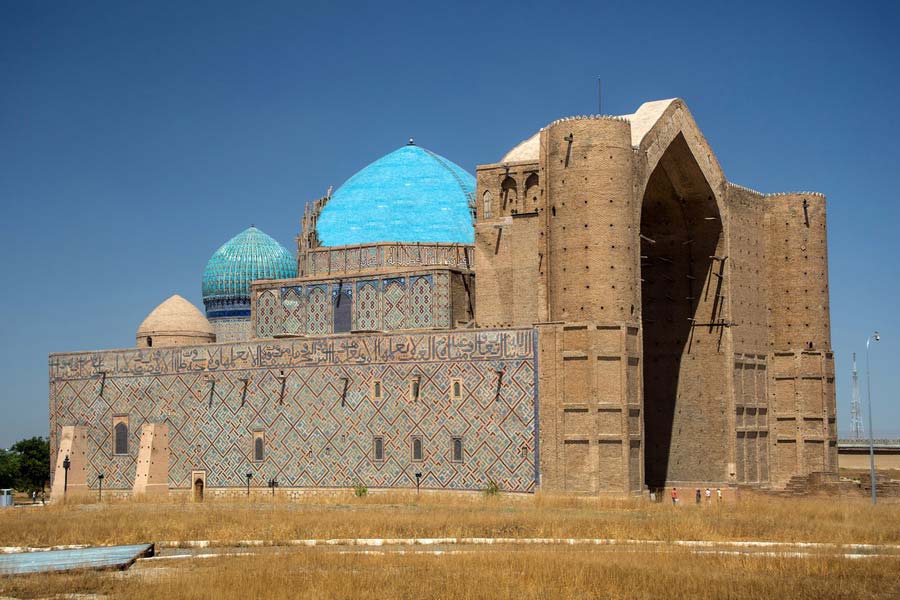Turkestan, Kazakhstan

Former names: Shavgar, Yassy
Elevation: 214 m
Popular languages: Kazakh, Russian
Population: 164 746 (2019), www.stat.gov.kz
Time zone: UTC +5
Phone code: +7 72533
Zip code: 161200
Automobile codes: 13
The elegant decor, patterned ceiling vaults and colorful majolica tiling capture the imagination.
1500 year old Turkestan became famous, thanks to the preaching of the most famous Sufi Sheikh, the outstanding poet and humanitarian Khodja Akhmed Yassaui, also called Khazret-Sultan. At that time the city was known as Yassy.
The theological school established by Yassawi attracted those craving for knowledge, both from the neighboring cities and outlying steppes of Kazakhstan. The city became the most significant center of enlightenment in Kazakhstan. The memorial complex which developed on the grave of the great Yassawi, turned into one of the most visited places of worship in Central Asia.
In the late 14th c. Turkestan acquired a unique structure - a large complex centered around the Mausoleum of Khodja Akhmed Yassaui, built by the Great Timurlane. In the Muslim World, Khodja Akhmed Yassaui Mausoleum is considered to be a "second Mecca".
The height of the huge building, which has witnessed many historical disasters and was opened recently after a restoration, is about 40 meters. The mausoleum is a marvelous complex of palaces and temples. It has over 30 rooms and halls; diameter of the main dome is 22 m. Its elegant decoration, patterned ceiling arches, and color mosaic majolica look stunning. In its central hall, the covered residence of the Kazakh Khans, has been opened a peculiar museum - the pantheon. The pearl of its exposition is the Kazan, the biggest cast water vessel throughout the Muslim East. It was made of the alloys of seven metals.
The Azret-Sultan historical and cultural reserve includes Turkestan and Kultobe cities, a necropolis, mausoleums (15th-17th cc.), Dzhuma mosque (19th c.), restored Big Hilvet (12th с.), chilakhana (room for rituals and prayers) (14th c.), bath-house (17th-19th cc.) and a fragment of the original citadel wall (19th c.) with gates (18th-19th cc.).
Out of the 802 historical and cultural memorials of South Kazakhstan region, 528 are monuments of archaeology, 42 historical monuments, and 226 architectural monuments.
The most interesting archaeological monuments are related to the epoch of the Karahanids - 9th-12th cc. It was a time when on the Great Silk Roadflourished the famous city of Otrar, where for several dozen years a large archaeological excavations has been carried out, and which is now a part of the historical-cultural reservation 'Otrarskiy oasis' and an interesting tourist attraction.
Here is a fine historical museum, with a panorama demonstrating the taking of the city by the Mongolians, and also a monument of the 12th-20th cc., Mausoleum Arystan-baba, dedicated to one of the sufi saints. The Mausoleum attracts a number of pilgrims from all over Central Asia. A pilgrimage center and hotel operate at this site.
The whole city center consists of the historic and cultural reservation, Azret-Sultan. Aside from the mausoleum of Hodzha Ahmed Yassavi, the complex includes a preserved medieval bath, a hilvet were the great saint lived, the mausoleum of the great granddaughter of Timur Rabiyi-Sultan Begim, among other monuments. Among these, preserved by some miracle, is a house for underground meditation, Kumshik-Ata.
40 km to the North of Turkistan, among the dry steppes, also preserved by a miracle since the 17th century, are the picturesque ruins of the ancient town of Sairan, famous for the Great Silk Road.
Deserving of mention among historical places is the Ordabasy rift, currently declared a historical reservation. Here, 30 km from Shymkent, at the beginning of the 18th c. Kazakhs united to resist invaders from Western Mongolia - the Dzungars.
There are monuments of architecture from the 19th c. in the region represented by mosques and medrassahs, among which is the distinguished architectural complex Appak-lshan, in the village of Charyn, as well as Orthodox churches built by Russian setters.
In the steppe near Turkestan, on a hill, sits the Domalak-Ana mazar (tomb)(early 20th c.) It was built in honor of "the Great Mother Babishar, daughter of Aksultan ". Domalak-Ana was a clairvoyant noted for her prophetical talents. According to popular beliefs, the three Kazakh Zhuzes (tribes) are descended from her three grandsons Alban, Suan and Dulat. Dying Domalak-Ana asked to be laid on a white female camel.
Baidibek was a hero, who held a leading position in the unification of the Kazakh people and their struggle against their enemies. The mausoleum of Baidibek-Ata lies near the mausoleum of Domalak-Ana. Many people pay tributes of respect to their ancestors here.
